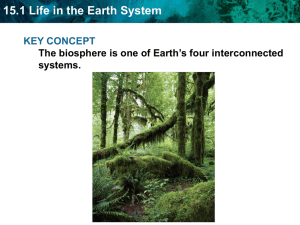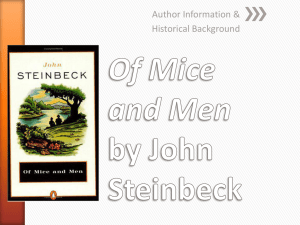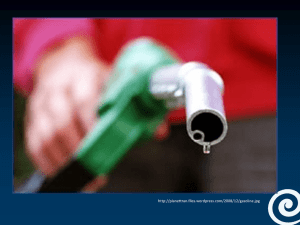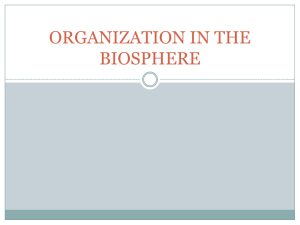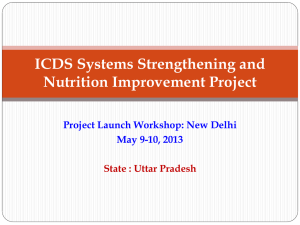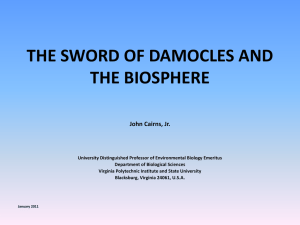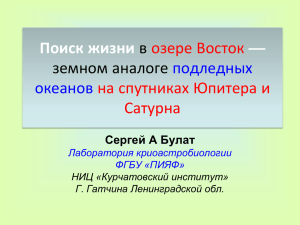Topic 1 Systems and models
advertisement
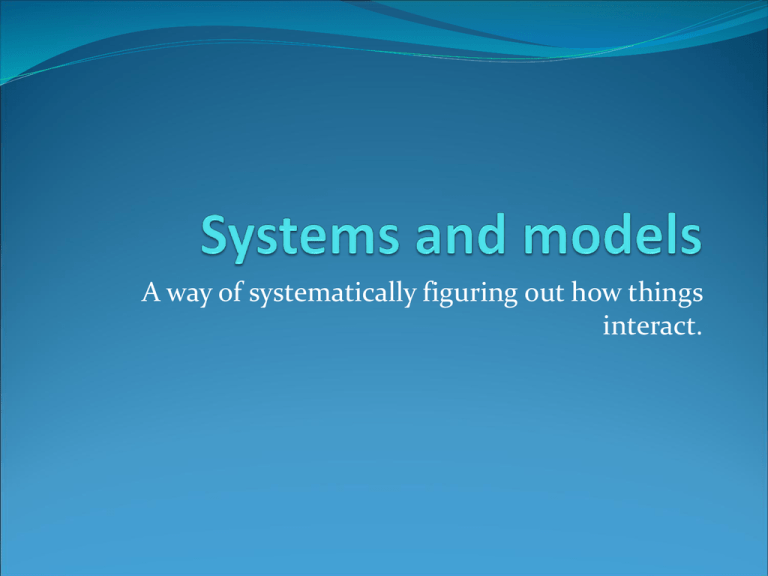
A way of systematically figuring out how things interact. rd 3 rock from the sun. The Earth from space The Earth is the only Biosphere so far… What is a biosphere? The thin bit of the whole planet earth where life can be found: 1. The Atmosphere – the air 2. The Lithosphere – the rocks 3. The Hydrosphere – the lakes, seas and oceans 4. The Ecosphere – the living bits The Layers of Earth Outline the concept and characteristics of ecosystems. An ecosystem consists of the interactions between the living and non living. The living is called biotic. The non-living interactions are called A-biotic. Put the following in the correct column: Biotic Abiotic Predation temperature parasitism humidity competition light intensity mutualism season soil pH Predation, temperature, parasitism, humidity, competition, light intensity, season, soil pH, mutualism, What is a system? “A system is an assemblage of parts and their relationship forming a functioning unit”* A system can be made up of living things, non-living things or mixes of both. It can be a whole variety of sizes, from cells to cities to biospheres. Big systems can be made up of many little systems. Eg. Organisms, organ systems, organs, tissues, cells, organelles…… *IBO Environmental Systems and Societies subject guide. (Page 75.) Some examples of systems: Sydney Cityscape A Eukaryote cell Human anatomy A motorbike To make a system diagram there are some conventions: All systems have They are represented as: Storages (of matter or energy) Boxes Flows (in, thru’ and out) Arrows - Inputs - Arrow in to the system - Outputs - Arrow out of the system Boundaries Processes (transfers or transformations) -------------------------Label on the arrows eg - Respiration Using the model below, draw your own systems diagram for the following: • A candle • A mobile phone • A green plant Inputs flows • You • A forest • A Lake • A scooter Storages flows • A cell • A city Taken from page 72, Environmental Systems and Societies – Course Companion – Jill Rutherford - 2009 - Oxford Outputs Types of System 1. An open system – exchanges energy and matter with what is around it. 2. An closed system – exchanges energy but not matter with it’s surroundings. 3. A isolated system – exchanges neither energy nor matter with its surroundings. Find and explain examples for each type. Look up ‘Biosphere 2’. What sort of system were they trying to create? Draw a systems diagram for the project. (Maybe you will need to draw one diagram for each biome and link the biomes.) Biosphere 2 http://en.wikipedia.org/wiki/Biosphere_2 http://www.biospherics.org/experimentchrono1.ht ml Was Biosphere 2 open, closed or isolated? Explain why? Why was NASA so interested in what went on at Biosphere 2? If you’re interested - Lake Vostok http://en.wikipedia.org/wiki/ Lake_Vostok Is this an isolated system? If not why not? If not isolated is it closed? Lake Vostok. http://www.ldeo.columbia.edu/~mstuding/new_vostok_cartoon_low.gif The Laws of Thermodynamics Thermodynamics is about the flow of energy (Thermo – heat Dynamics - movement.) The 1st law states: - Energy cannot be created or destroyed; it can however change from one form to another. The 2nd law states: - In any isolated system entropy tends to increase spontaneously. What does this mean? Why is it relevant? The first law is easy……we call these energy changes “transfers” or “transformations” A Transfer – is a change in position of the energy but not a change in form. (eg. Rain falling from a cloud) A Transformation – a change in the form or state of the energy. (eg. light energy changing to chemical energy in photosynthesis. Or evapouration of water from the sea to the atmosphere. ) …The 2nd Law Entropy – a tendency to fall apart or become more disordered. Usually energy is lost from a system as heat. (this heat is gained by another system though – see the 1st law!) The energy available to do work in a system gets less. A Food Chain The arrows represent the flow of energy from eaten to eater! Producer * Primary consumer *All images from clip art except – Apple tree. Secondary consumer Tertiary consumer Energy losses: The apple is only able to absorb some of the light. (It reflects the green) (Normally 2% efficiency) The worm must find the apple – this takes wiggling and changes chemical to movement energy and heat. (Normally less than 10% efficiency) The little bird must fly to catch the worm and escape the big bird …..as above.(Normally more 10% efficiency) The big bird…… (Normally 10% efficiency) The total efficiency of the big bird = 0.02 x0.1x0.1x0.1 = 0.00002% Sooo………. When energy passes through living things it is used by the organism and eventually lost to the environment as heat. Equilibria - balances Equilibrium is the tendency of a system to return to an original state after it gets disturbed. 1. Steady state – stuff goes into the system stuff; goes out of the system; the amount of stuff in the system stays the same. 2. Static – nothing goes in; nothing comes out; the amount of stuff in the system stays the same. Stable and unstable equilibria • Stable: even quite a large disturbance will return to the ‘status quo’. • Unstable: even a small disturbance will upset the balance. • Some stable systems resist change: • Sometimes the change is so great it moves to a NEW stable position: Feedback Feedback is often responsible for keeping or upsetting balances: There are 2 types of feedback; Positive (+ve) feedback Tends to destabilize equilibrium; pushing a system to a new state. Negative (-ve) feedback Tends to stabilize systems and resist change. It allows self regulation. Same system 2 ideas: Climate temperature Less heat comes in -ve More reflection of sunlight Climate temperature Increased temperature Increased evaporation More cloud Climate temperature remains constant Less heat escapes +ve More insulation of heat Increased temperature Increased evaporation More cloud Climate temperature increases Which is stable? What type of feedback is this? Which is unstable? What type of feedback is this? Learn these definitions! Negative feedback is a self regulating method of control leading to the maintenance of a steady state equilibrium – it counteracts deviation. Eg. Predator prey relationships. Positive feedback leads to increasing change in a system – it accelerates deviation. Eg. Population growth. Bibliography - Images Slide 2 – The Earth from space – NASA -http://farm3.static.flickr.com/2084/2222523486_5e1894e314_b.jpg August 30th 2010 Slide 4 – The Layers of Earth - http://www.solcomhouse.com/images/struct.jp - August 30th 2010 Slide 7 Human anatomy - Renarf - http://media.photobucket.com/image/human%20body/renarf/Zygote-3D-MaleHuman-Anatomy-Collec.jpg - August 30th 2010 A Eukaryote cell - Chad Williams http://www.williamsclass.com/SeventhScienceWork/ImagesCells/EukaryoticCell.jpg - August 30th 2010 Sydney Cityscape – Roger Waite -http://www.rogerswebsite.com/Australia/14%20%20Sydney%20City%20Skyline.jpg – August 30th 2010 A Motorbike – Yamaha UK - http://www.yamaha-motor.co.uk/Images/2009-X-City-125-static-04_prv_tcm46280314.jpg – August 30th 2010 Slide 11 : Lake Vostok – Michael Studinger http://www.ldeo.columbia.edu/~mstuding/new_vostok_cartoon_low.gif - August 30th 2010. Slide 16 : Apple tree – Andy and Dave Hamilton – www.selfsufficientish.com - August 30th 2010.
